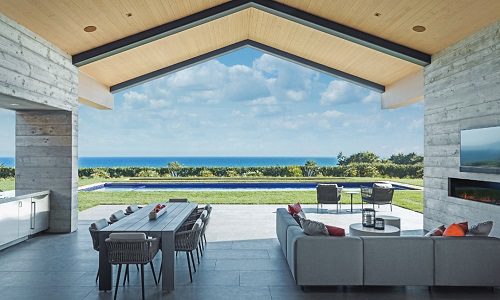If you’re working on a home with a covered patio or screen porch as an outdoor living space, you might start to wonder if you can simply install an indoor TV outside rather than shelling out the extra bucks for a specialty model.
Maybe, you think to yourself, it’ll be fine since the home is in a warmer climate, you’re not likely to get a lot of precipitation and it’s going to be all contained within a covered porch as well. To save you the trouble and the cost of buying your client an expensive, new big-screen TV: Don’t.
Can You Use an Indoor TV Outside?
Even if you’re going through extra effort to protect it, an indoor TV cannot and should not be used outside. Only TVs that are properly rated or protected by some weatherproof enclosure are safe to use outdoors.
Aside from rain, the moisture in the air, dust, grit, sunlight and insects can quickly ruin a TV not designed for the outdoors, and that’s not mentioning how the video quality might suffer, considering many indoor TVs are designed with low ambient light conditions in mind.
Why You Shouldn’t Use an Indoor TV Outdoors
Just to make sure you’re still not tempted let’s break down all the reasons as to why it’s a bad idea to install an indoor TV outside.
1. Installing an Indoor TV Outside Can be Dangerous
Open the first page of any TV manual, and you’ll see a section warning you about the dangers of putting an indoor TV outside. Besides the risk of electrocution, one small short, and your cheap TV can cause some expensive damage.
“Indoor TVs are not designed for exposure to the elements like rain, snow, and extreme temperatures,” explains JD Fulks, Senior Product Manager at Snap One.
“In fact, most indoor TV manuals warn against using an indoor TV outdoors, which can void the warranty and lead to dangerous consequences like electrical shock or fire. For this reason, outdoor TV certification for all-weather use by an independent lab (like UL) is essential to verify the product can be used safely outdoors.”
Plus, a TV shock or short due to moisture can cause damage to other connected devices, which means more equipment you may have to replace.
2. Even Under an Enclosure, the Elements Can Wreck Your TV
Humidity, dust, and sunlight can all compromise the inner workings of your TV if it is not properly protected against the elements. Outdoor TVs with an Ingress Protection (IP) rating of IP54 or above mean the TV will be adequately sealed from water spray or dust from any angle, which would not be present in the design of indoor TVs, says Earl Naegele, Director of Commercial Sales at Peerless-AV.
“The National Electrical Manufacturers Association (NEMA) [also] sets standards for electrical equipment that will be exposed to the elements. A NEMA 6 rating is a widely accepted industry standard for outdoor TVs as this protects against dirt, ice, and contact with water, while an indoor TV would not be protected,” explains Naegele.
3. TV Performance Will Likely Suffer If It’s Not Outdoor Rated
No one wants to watch a picture with obtrusive glare or black spots, but that’s what you’ll be faced with when your TV isn’t equipped for the outdoors.
Excess sunlight can cause temporary black spots, or even permanently damage the LCD panel of an indoor TV. As Matthew Barber, Hisense Product Marketing Manager, explains, indoor TVs don’t use the same housing materials or cooling technology as outdoor televisions which make them more susceptible to dramatic temperature swings and glare.
Even for outdoor TVs, it’s important to confirm the level of direct sunlight the TV is engineered for before installing in an area with direct sunlight.
Aside from causing direct damage, the higher ambient light found outdoors can dramatically reduce the picture fidelity of an indoor TV. Outdoor TVs are not only built to be brighter than many indoor TVs, but many feature anti-glare screen technologies and can resist extreme temperatures.
4. What You Save in Money You Pay for in Longevity
The initial purchase price for indoor TVs is often lower, but the total cost of ownership may be significantly more than an outdoor TV. A true outdoor TV should produce years of enjoyable viewing, while an indoor TV may need to be replaced multiple times and require multiple installations.
For homeowners, it’s a huge waste of money. For professional installers, it’s a huge waste of time having to go out time and time again, all to replace a TV. No one wants to research and shop for TVs over and over for the same application and CE pros certainly do not want to return to the same job multiple times to hang a TV again.
5. Installing an Indoor TV Outside Could Lead to Warranty Issues
It’s simple: If you install an indoor TV outside, you’re voiding the warranty. So if your picture goes out on the very first day, you’re out of luck (and some serious cash).
True outdoor TVs are warranted for outdoor use. This means if they develop performance issues within the warranty period even with exposure to the elements the TV was designed for, defects will be covered by the Manufacturer’s Warranty. Indoor TVs are only warrantied for indoor use.
How Do You Weatherproof a TV for Outside?
While there is little you can do to weatherproof an indoor TV to become an outdoor TV (and even if you could, it would likely cost just as much as buying an outdoor-rated TV outright), you can purchase extra protection for your outdoor TVs.
Specialty TV enclosures and cabinets can provide some extra protection for your outdoor TV. These specialty piece of equipment often come with extra protection from moisture and insulation to help protect your TV against extreme temperature shifts.
What are the Best Outdoors TVs?
When buying an outdoor TV, you have quite a bit of options on the market. For a company known for its indoor TV offerings, Samsung offers an outdoor option as well, in the form of The Terrace. There are also brands like SunBrite, Furrion and Neptune by Peerless-AV that are exclusively focused on developing outdoor-rated TVs and TV enclosures.
We look at a number of professional options that range from affordable to top-of-the-line in our list of top picks for outdoor TVs for professional installers.







